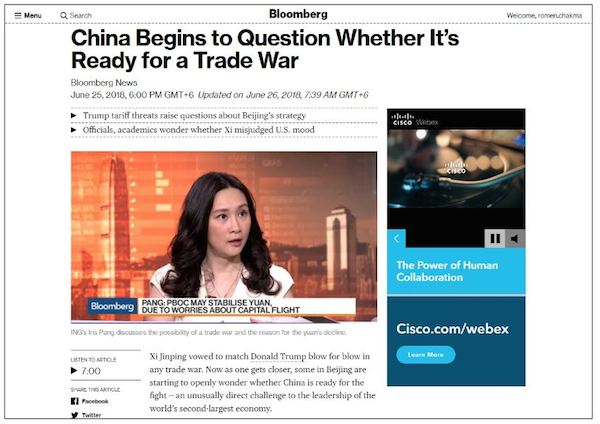Join us Dec. 1-3 in New Orleans for the Digiday Programmatic Marketing Summit
Bloomberg Media takes a stab at overhauling the display ad
Bloomberg Media is the latest publisher to try to breathe new life into the display ad with a new ad format it calls Ad.apt that takes an advertiser’s basic assets like a video and headline and turns them into one of four ad variations, showcasing video, data or related Bloomberg news articles. It also tailors the ad to viewers based on their browsing history.

“It’s about driving more impact in a more efficient way,” said Derek Gatts, global head of ad trafficking, technology and product at Bloomberg Media. “Standard banners don’t perform the way anyone would like them to.”
The ad format follows the IAB’s move to encourage publishers to adapt display ad units that adjust to different screen sizes and resolutions and also adopt the IAB’s principles of non-invasive, unobtrusive ads that are less prone to be ad-blocked. Publishers like The New York Times with Flex Frame have already put out their own flexible display ads that replace standard banner ads whose prices have come down as their effectiveness has been questioned.
“Banners kind of stink,” said Chris Wexler, svp and executive director of media and analytics at Cramer‑Krasselt. “Everyone’s trying to break the downward pressure on pricing that excess inventory brings to digital. As advertising gets more interested in audience-based, it puts more pressure on publishers to build something unique.”
Bloomberg’s answer is to use the trove of data it has on its readers to customize the Ad.apt ads. It can spit out different formats and then tweak the creative by watching where readers hover and click, down to the color of the call-to-action buttons to the headline. They’re being sold direct and programmatically.
“We’ll be able to say, this particular kind of audience resonates with a red button, this resonates with a blue button; this type of headline resonates with a CEO whereas a CTO resonates with this type,” Gatts said.
If that sounds creepy, Gatts said Bloomberg isn’t targeting ads to people based on their emotional state, as other publishers have and as it’s done in the past. He didn’t rule out doing so in the future, though. “We talk about what are the right conditions for an advertiser to message and what kind of message should they use,” he said.
The Ad.apt units also represent Bloomberg Media’s effort, along with other publishers, to reduce its reliance on external ad tech. In this case, Bloomberg for the first time is measuring the ads’ impact using Google Analytics, the same platform that it uses on the editorial side, to more easily compare data across the company.
“Lots of publishers talk about bringing things in-house and shedding reliance on third parties,” Gatts said. “We still use some self- and managed-service platforms, but we’re far less reliant on tech vendors than normal publishers are.”
Wexler said he can see such units working for advertisers that want an inexpensive option, but that “for premier brands, we want more control over our story. Most of the time that automated thing they might build isn’t the best user experience. I still have to take the time to project-manage it.”
Cisco is the first advertiser to use them, and a handful of others have signed on to use the Ad.apt formats, Gatts said, noting that a couple are luxury advertisers, often a highly particular bunch about how they advertise their brands. The company sees these ad formats becoming an important revenue producer, but beyond ad revenue, they also have applications for the editorial side. As it builds up information from more campaigns, Bloomberg also may use what it learns to personalize the site’s editorial content for each visitor.
“Julia and I talk about it a lot, the idea of automatically optimizing and leveraging the same data on edit; we’re always comparing notes,” said Gatts, referring to Bloomberg Media’s chief product officer, Julia Beizer.
More in Media

Marketers move to bring transparency to creator and influencer fees
What was once a direct handoff now threads through a growing constellation of agencies, platforms, networks, ad tech vendors and assorted brokers, each taking something before the creator gets paid.

Inside The Atlantic’s AI bot blocking strategy
The Atlantic’s CEO explains how it evaluates AI crawlers to block those that bring no traffic or subscribers, and to provide deal leverage.

Media Briefing: Tough market, but Q4 lifts publishers’ hopes for 2026
Publishers report stronger-than-expected Q4 ad spending, with many seeing year-over-year gains.








